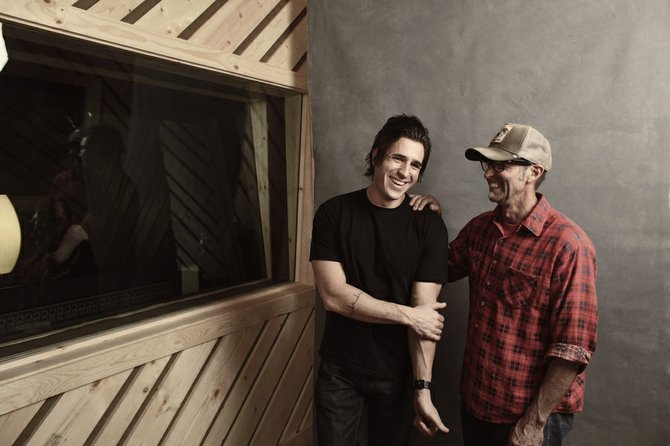 Facebook
Facebook
 X
X
 Instagram
Instagram
 TikTok
TikTok
 Youtube
Youtube

“Build a quality studio, fill the place with outstanding musicians, and the market will come to you.” This formula, hopes Jim Austin, will spell success for a new business venture he owns with Buckfast Superbee guitarist Timothy Joseph. The two entrepreneurs have put the finishing touches on a Mission Gorge–area recording studio they call Phaser Control.
Phaser Control is part of Studio 350, a complex of 17 band practice rooms that opened last year. Able to comfortably house a five- or six-piece band, the main studio is an exercise in weird geometry. The ceiling curves up, and the walls meet at funhouse angles. It smells like new wood. The heavy studio doors feel like airlocks on a space craft. Inside, the very atmosphere is different. The studio cost a small fortune to build, but Austin, who owns a guest ranch in Pioneertown and plays upright bass in Big Blue Tractor and Brawley, won’t say how much.
“The numbers didn’t scare me,” he says, “as long as it was gonna be done right.”
To that end, he and Joseph hired Rod Gervais, a Connecticut-based audio designer and the author of Home Recording Studio: Build it Like the Pros. Gervais, says Austin, was a hard-ass about details. But, how the room would actually sound at the end of the six-month build was anybody’s guess. “Gervais said you can’t really tell if the room is going to work until you hear the first recording,” says Joseph. So, does it work? Roland Ware thinks yes.
“I’m amped at the tones we were able to find in there.” Ware is a veteran record producer, owns Rdub Recordings, and was the first to record a complete project at Phaser Control.
For now Phaser Control is direct to digital. But first, vintage microphones funnel tones through the 1974 electronics of a Soundcraft 8000 mixing console that spent a decade at the Belly Up Tavern before it was brought out of storage and refurbished. The ancient electronics in the console, says Joseph, enhance the raw sound.
For now, most of the paid recording business is filtering into the studio via the musicians who rent the practice rooms. Joseph says they get half off when they book recording time. Although he doesn’t want to drop names, he says major music-business players who have seen Phaser Control have also shown interest in booking. But is it profitable? No, not yet. Joseph calls it a labor of love for now.
“We don’t have to have the studio pumping all the time as a part of our business model,” says Jim Austin. “The rentals pay the bills.”


“Build a quality studio, fill the place with outstanding musicians, and the market will come to you.” This formula, hopes Jim Austin, will spell success for a new business venture he owns with Buckfast Superbee guitarist Timothy Joseph. The two entrepreneurs have put the finishing touches on a Mission Gorge–area recording studio they call Phaser Control.
Phaser Control is part of Studio 350, a complex of 17 band practice rooms that opened last year. Able to comfortably house a five- or six-piece band, the main studio is an exercise in weird geometry. The ceiling curves up, and the walls meet at funhouse angles. It smells like new wood. The heavy studio doors feel like airlocks on a space craft. Inside, the very atmosphere is different. The studio cost a small fortune to build, but Austin, who owns a guest ranch in Pioneertown and plays upright bass in Big Blue Tractor and Brawley, won’t say how much.
“The numbers didn’t scare me,” he says, “as long as it was gonna be done right.”
To that end, he and Joseph hired Rod Gervais, a Connecticut-based audio designer and the author of Home Recording Studio: Build it Like the Pros. Gervais, says Austin, was a hard-ass about details. But, how the room would actually sound at the end of the six-month build was anybody’s guess. “Gervais said you can’t really tell if the room is going to work until you hear the first recording,” says Joseph. So, does it work? Roland Ware thinks yes.
“I’m amped at the tones we were able to find in there.” Ware is a veteran record producer, owns Rdub Recordings, and was the first to record a complete project at Phaser Control.
For now Phaser Control is direct to digital. But first, vintage microphones funnel tones through the 1974 electronics of a Soundcraft 8000 mixing console that spent a decade at the Belly Up Tavern before it was brought out of storage and refurbished. The ancient electronics in the console, says Joseph, enhance the raw sound.
For now, most of the paid recording business is filtering into the studio via the musicians who rent the practice rooms. Joseph says they get half off when they book recording time. Although he doesn’t want to drop names, he says major music-business players who have seen Phaser Control have also shown interest in booking. But is it profitable? No, not yet. Joseph calls it a labor of love for now.
“We don’t have to have the studio pumping all the time as a part of our business model,” says Jim Austin. “The rentals pay the bills.”
Comments